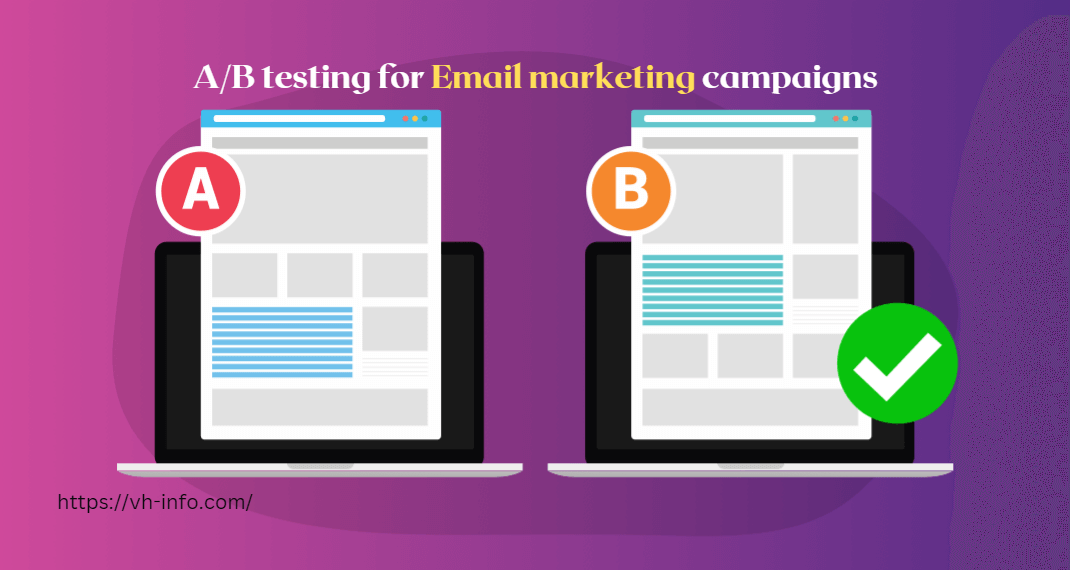Introduction of A/B testing for email marketing campaigns: What is it and why is it important?
A/B Testing for Email Marketing is Best! A/B testing is a powerful tool that helps marketers determine the effectiveness of their email marketing campaigns by comparing two different versions of an email.
A/B testing involves creating two versions of an email with slight variations, such as subject lines, email content, images, or CTAs, and sending them to a small group of subscribers. The version that performs better is then sent to the remaining subscribers.
A/B testing is essential in email marketing campaigns as it helps marketers improve their campaigns’ performance by identifying what resonates with their audience.
It provides valuable insights into what elements of an email drive engagement, conversions, and overall campaign success. By testing different variations, marketers can optimize their email campaigns for better open rates, click-through rates, and ultimately, revenue.
A/B testing can also help marketers gain a better understanding of their audience, allowing them to tailor their emails to the specific needs and preferences of their subscribers.
This can lead to more personalized and relevant content, which is crucial in today’s highly competitive email marketing landscape.
Overall, A/B Testing for Email Marketing is an essential component of any successful email marketing campaign, and it is crucial for marketers to utilize this tool to improve their email campaigns’ effectiveness.
Setting up an A/B test for email marketing campaign: Best practices and tips
When setting up an A/B test for your email marketing campaign, there are several best practices and tips to consider to ensure accurate results and meaningful insights.
Firstly, it is essential to define the objective of the A/B test and determine which element of the email you want to test.
No matter the type of site, using A/B testing in the email campaigns is crucial. For example, Wix developers and email marketers can ensure that their messages are reaching their intended audience and driving results.
This could include subject lines, email content, images, CTAs, or other variables. It is also important to ensure that the test is conducted on a statistically significant sample size to ensure accurate results.
Secondly, it is important to create two versions of the email that are identical in all other aspects except for the variable being tested.
This ensures that any difference in performance can be attributed to the variable being tested.
Thirdly, it is essential to randomize the sample and ensure that each segment receives the same email at the same time to avoid external factors influencing the results.
Lastly, it is important to measure the results accurately and make data-driven decisions based on the performance of each version of the email.
By following these best practices and tips, marketers can set up an effective A/B test that provides valuable insights into their email campaigns’ performance and enables them to optimize their email campaigns for better results.Bonus Read: HARO Link Building: A Comprehensive Guide to Building Backlinks with HARO
A/B testing for email marketing subject lines: Tips and best practices
Subject lines are one of the most critical elements of an email marketing campaign, and testing them is crucial for maximizing open rates and engagement. When conducting A/B testing on subject lines, there are several tips and best practices to consider.
Firstly, it is important to test one variable at a time, such as the length, tone, or personalization of the subject line. This allows for accurate results and insights into what drives open rates.
Secondly, it is important to ensure that the subject lines are concise, clear, and relevant to the email’s content. A/B testing tool can help identify which types of subject lines resonate best with your audience.
Thirdly, it is essential to segment your audience and test different subject lines on different segments. This allows for a more personalized approach, leading to better engagement rates.
A/B testing for email marketing content: Tips and best practices
A/B testing email content is an effective way to determine what resonates best with your audience and drives engagement. When conducting A/B testing on email content, there are several tips and best practices to consider.
Firstly, it is essential to test one variable at a time, such as the length, format, or tone of the email content. This allows for accurate results and insights into what drives engagement rates.
Secondly, it is important to ensure that the email content is relevant, personalized, and valuable to the audience. A/B testing can help identify which types of content resonate best with your audience and lead to higher engagement rates.
Thirdly, it is essential to segment your audience and test different content on different segments. This allows for a more personalized approach, leading to better engagement rates.
Lastly, it is crucial to measure the results accurately and use the insights gained to optimize future email marketing strategies and campaigns.
By following these tips and best practices, marketers can effectively A/B test their email content, leading to improved engagement rates and conversions, additionally improve their email campaign management efforts, ultimately, campaign success. It is also an essential part of digital marketing strategies.
Read More:A/B Testing for Email Marketing Campaigns: Tips and Best Practices
A/B testing images and visuals: Tips and best practices
A/B testing is a popular technique used to compare the performance of two different versions of a web page or app. When it comes to testing images and visuals, there are a few tips and best practices that can help ensure the most accurate results.
Firstly, it’s important to clearly define the goal of the test. This could be anything from increasing engagement to improving conversion rates.
Once the goal is established, create two versions of the page with different images or visuals and randomly split traffic between them. Make sure all visuals are high quality—tools that unpixelate images can help enhance clarity and ensure a more professional appearance.
When selecting the images or visuals, consider the audience and the context in which they will be viewed. For example, an image that works well on social media may not be as effective on a landing page. It’s also important to test only one variable at a time to accurately measure the impact of the change.
It’s essential to track and analyze the results of the test to determine which version performs better. This includes metrics such as click-through rates, conversion rates, and engagement rates. Based on the results, implement the winning version and continue to test and optimize as needed.
In summary, A/B testing images and visuals requires a clear goal, thoughtful image selection, tracking and analyzing results, and continued optimization.
By following these best practices, businesses can make data-driven decisions to improve their digital presence.
Read More: improving conversion rates.Read more about : Email marketing tool Like Brevo
A/B testing call-to-actions (CTAs): Tips and best practices
Call-to-actions (CTAs) are a critical element of any website or app as they drive users to take a desired action. A/B testing can be a powerful tool for optimizing CTAs to increase click-through rates, conversion rates, and overall user engagement. Here are some tips and best practices for A/B testing CTAs.
Firstly, make sure to clearly define the goal of the test. This could be anything from increasing sales to growing a mailing list. Once the goal is established, create two versions of the CTA with different text, color, placement, or design and randomly split traffic between them.
When selecting the CTA text, use clear and action-oriented language that is specific to the user’s needs. Test different variations to see which resonates best with the target audience.
It’s also important to test the CTA placement on the page to see where it has the highest impact. Consider factors such as visibility, proximity to relevant content, and overall design.
Finally, track and analyze the results of the test to determine which version performs better. Based on the results, implement the winning CTA and continue to test and optimize as needed.
In summary, A/B testing CTAs requires a clear goal, thoughtful text, and placement selection, tracking and analyzing results, and continued optimization.
By following these best practices, businesses can improve the effectiveness of their CTAs and drive more user engagement.Bonus Read: How to Find Competitor Backlinks to Improve Your Link-Building Strategy in 2023
Analyzing A/B testing results: best practices and tips
Analyzing A/B testing results is crucial in optimizing a website or app performance. Here are some best practices and tips to help businesses effectively analyze their A/B testing results.
Firstly, track relevant metrics such as click-through, conversion, and engagement rates for both the control and experimental groups.
It’s also important to ensure that the sample sizes are large enough to provide statistically significant results.
Once the results are in, compare the performance of the control group with the experimental group to determine which version performed better.
It’s important to consider the magnitude of the improvement but also the level of statistical significance.
Additionally, it’s important to look beyond just the overall performance metrics and analyze how different user segments performed.
This can provide insights into how different audiences interact with the website or app and can inform future optimization efforts.
Finally, document the results and insights gained from the A/B testing process. This can help inform future testing and optimization efforts and ensure that the business is continuously improving its digital presence.
In summary, analyzing A/B testing results requires tracking relevant metrics, comparing control and experimental groups, analyzing different user segments, and documenting insights.
By following these best practices, businesses can make data-driven decisions and continually optimize their website or app performance.
Read More:A Complete Guide to 2023 Business Roadmaps
A/B testing frequency: best practices and tips
A/B testing is a powerful technique that allows businesses to determine the best version of their website, app, or product by testing two variations against each other. However, deciding how often to perform A/B testing can be tricky.
There is no one-size-fits-all answer since the frequency of testing depends on various factors such as the size of your user base, the complexity of your product, and your testing goals.
Generally, it’s best to conduct A/B tests at regular intervals, such as once a month, to avoid making significant changes that could harm the user experience.
However, if you’re making frequent updates to your product, you may want to test more often to ensure that each change is well received by users.
Additionally, if you’re experiencing low traffic volume, you may want to extend your testing period to ensure that you have enough data to make informed decisions.
When conducting A/B tests, it’s essential to ensure that your test variants are statistically significant, meaning that they have a large enough sample size to make confident conclusions.
It’s also important to have a clear hypothesis and testing plan, so you don’t waste resources testing ideas that don’t align with your goals.
Overall, the frequency of A/B testing should be based on your business needs, testing goals, and user behavior. By following best practices and regular testing, you can improve your product’s performance and user satisfaction over time.
Common mistakes to avoid when conducting A/B testing for email marketing campaigns
A/B testing can be a highly effective tool for optimizing email marketing campaigns, but it’s essential to avoid common mistakes that could compromise the accuracy and relevance of your results. Here are some common mistakes to avoid when conducting A/B testing for email marketing campaigns:
- Testing too many variables at once – It’s essential to test one variable at a time to understand its impact on the email campaign’s performance.
- Failing to establish a clear hypothesis – Without a hypothesis, it’s challenging to understand the results and make data-driven decisions.
- Testing with an inadequate sample size – You need a sufficient sample size to obtain statistically significant results.
- Ignoring the timing and frequency of your email campaigns – Timing and frequency can significantly impact the performance of your email campaigns, so it’s essential to test these variables as well.
- Not testing both subject line and content – Testing both the subject line and email content will provide a complete picture of the impact of your email marketing campaigns.
By avoiding these common mistakes and following best practices, you can conduct effective A/B testing for email marketing campaigns, leading to higher open and click-through rates and increased engagement with your audience.
Conclusion: A/B testing for email marketing campaigns
A/B testing is a powerful tool for optimizing email marketing campaigns. By testing different variables such as subject lines, email content, timing, and frequency, businesses can determine the most effective strategies for engaging their audience and achieving their marketing goals.
However, it’s important to approach A/B testing for email marketing with a clear hypothesis and testing plan and to avoid common mistakes such as testing too many variables at once and using an inadequate sample size.
By following best practices and testing regularly, businesses can improve their email marketing campaigns’ performance over time.
A/B testing for email marketing allows businesses to make data-driven decisions and optimize their email marketing campaigns to achieve higher open and click-through rates, increased engagement, and ultimately, greater revenue.
By focusing on testing one variable at a time and using statistically significant results, businesses can confidently implement changes that will lead to more successful email campaigns.
In conclusion, A/B testing is an essential practice for email marketers looking to improve their campaigns’ performance and engagement.
By conducting regular tests and avoiding common mistakes, businesses can achieve greater success in their email marketing efforts.
Raj Panchotiya
Raj Panchotiya is a Head of link building projects at vh-info. He loves to talk about Marketing and Social media. In his free time, he likes to read & stay updated on the marketing!
You can always reach out to Raj on LinkedIn



